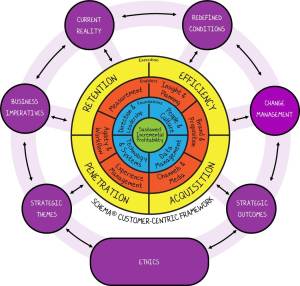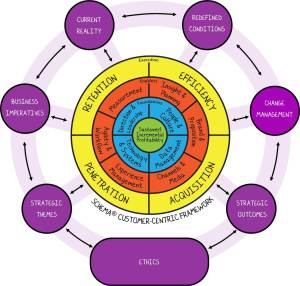Designing and executing a customer-centric business model requires end to end organisational alignment. Customer-centric capability development cannot take place in isolation to the rest of the business. The customer-centric journey requires a clear quantified understanding of current organisational capability across all 14 capability areas of the SCHEMA® Customer Management framework in the centre of the REAP Customer-Centric Blueprint below. As important as an understanding of current customer management capability is, so too is an understanding of the capability to which the organisation aspires.
Each week I’ll address another single capability area, sharing with you the Transformation Intent to which your organisation should commit to, as well as ‘What Good Looks Like’ for those organisations that have achieved a fairly high level of maturity in the respective capability area.
The REAP Customer-Centric Organisation Blueprint®
This week we are dealing with Acquisition which is one of the four Execution capability areas represented. The Execution layer relates to the capabilities and control levers needed to optimise customer value and includes Retention, Efficiency (understanding cost to serve), Acquisition and Penetration (customer development, cross-sell and up-sell) – collectively referred to as REAP. These are capabilities and initiatives that can be optimised in the short term.
These capabilities support your ability to implement your chosen customer strategies and rely on the fundamental building blocks (Foundations) as well as the Enabling capabilities already discussed in Part 1 to 10 of this series of blog posts.
Each of the four Execution capability areas is made up of sub-components. The Acquisition dimension focuses on the specific, practical activities that will support you to increase both the quality and volume of new customers. Acquisition explores ways in which you can increase the size of your customer universe and your share of it. The 5 sub-components of the Acquisition dimension are ‘Understanding Acquisition,’ ‘Identifying New Prospects,’ ‘Managing Interest,’ ‘Converting Sales,’ and ‘Setting up & Activating.’ Each of these areas is addressed in separate, individual blog posts.
Transformation Intent – Acquisition
“A customer-centric Acquisition approach begins with a clear and intimate understanding of your customer universe and the factors that impact your ability to sell to them. Acquiring your share of this customer universe is achieved through appropriate targeted marketing activity across a broad range of relevant channels and media, and interest generated is managed effectively so that prospects are kept warm until the sale is closed. While the sales process itself should focus on closing the sale, it should also take into account effective lead management, specific sales targets and rewards and careful controls over pricing. Customer-centricity also recognises that new clients have not been secured until you have taken them through an experience-based initiation process, where they are made to feel welcome and are well informed.”
What Good Looks Like – Identifying New Prospects
- The nature of target customers is defined and best potential sources (locations, current suppliers, groupings) of these types of potential customer have been identified.
- Use is made of all relevant channels of influence and referral both at the individual advocate / trusted advisor level and at the level of influencing bodies and networks. This includes the active exploitation of referrals between business units of the organisation.
- All pro-active acquisition marketing activity, across all media including social media, is tightly targeted to ensure the highest probability of gaining an attractive mix of new customers efficiently and cost effectively. Marketing activity is effectively terminated where it is resulting in the identification of a poor mix of prospects.
- Good quality customers who have been lost in the past are targeted for appropriate winback activity, using relevant messages for their reason for leaving, at the right time to ensure the best chance of winning back the most valuable ones.
For more insight into customer-centric business model innovation as well as more insight into this particular area of the REAP Customer-Centric Blueprint, please see my book “The Customer-Centric Blueprint’ – http://amzn.to/ZILg4y
Filed under: 21st Century Organisation, Best Practice, Business Models, Change Management, Competitive Advantage, CRM Models, Customer Acquisition, Customer Experience, customer management, Customer Relationship Management, Customer Strategy, Frameworks, Innovation, Leadership, Measurement, Sustainable Business Performance | Tagged: 21st century organisations, Big Thinking, business innovation, business performance, business strategy, capability areas, capability development, company strategy, CRM, customer centricity, customer experience management, customer managment, customer service, customer strategy, data integrity, execution, Inspiration, marketing, marketing ROI, organisational alignment, Sustainability, thinking customer, Vision | Leave a comment »



